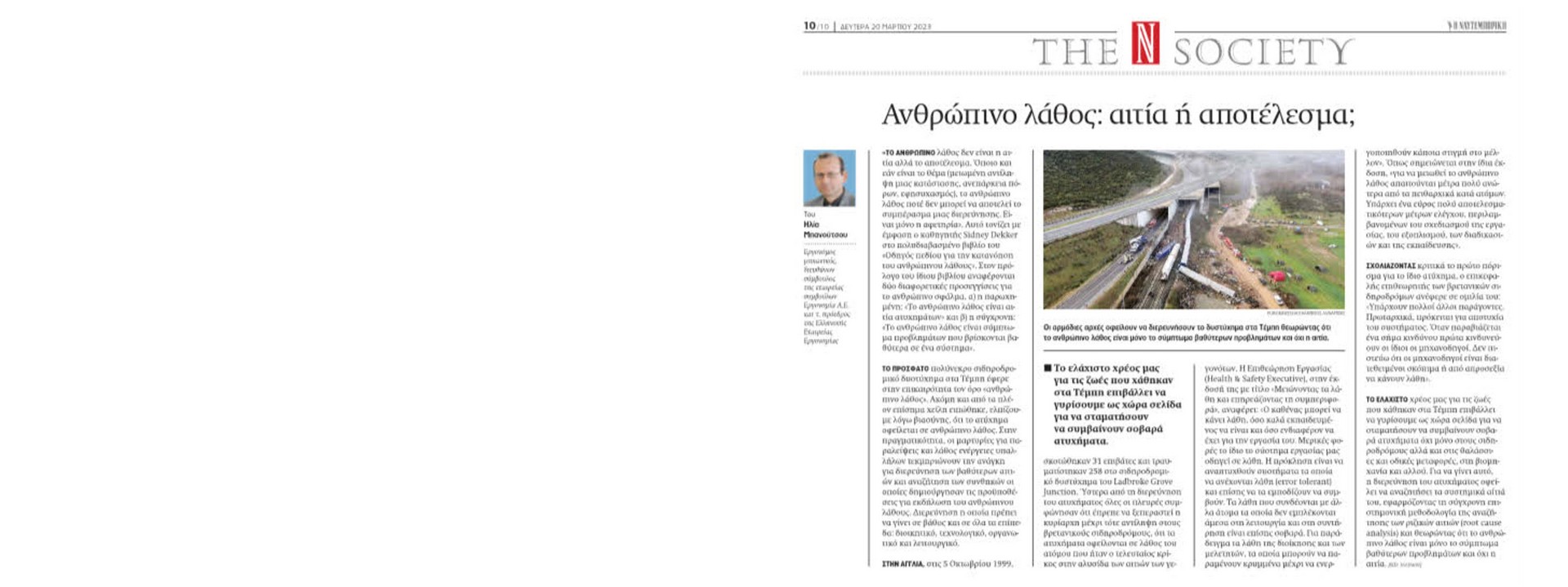Human Error: Cause or Effect?

by Ilias Banoutsos
Ergonomist-Production Engineer, CEO of ERGONOMIA SA,
ex. President of the Hellenic Ergonomics Society
"Human error is not the cause but the effect. Whatever the issue (reduced perception of a situation, insufficient resources, complacency), human error can never be the conclusion of an investigation. It's just the starting point."
This is emphasized by Professor Sidney Dekker in his widely read book "Field Guide to Understanding Human Error".[1] The preface of the same book mentions two different approaches to human error, a) the obsolete: "Human error is a cause of accidents" and b) the modern: "human error is a symptom of problems deeper in a system".
The recent railway crash at Tempe/Greece on February 23rd 2023, resulted to 57 passengers being killed and more than 85 injured. This deadly accident has brought the term human error into the news. Even from the most solemn lips it was said, hopefully out of haste, that the accident was due to human error. In fact, testimonies of omissions and wrong actions of employees substantiate the need to investigate the root causes and search for the deeper causes that created the conditions for the manifestation of human error. Investigation, which must be conducted in depth and at all levels, administrative, technological, organizational and operational.
In England on 5 October 1999, 31 people were killed and 258 passengers injured in the Ladbroke Grove Junction rail accident. Following the investigation of the accident, all sides agreed that the prevailing perception on British railways that accidents were due to the fault of the person who was the last link in the chain of causes of events had to be reviwed. The Labour Inspectorate (Health & Safety Executive) in its publication entitled "Reducing errors and influencing behaviour “[2] mentions: “Everyone can make errors no matter how well trained and motivated they are. Sometimes we are ‘set up’ by the system to fail. The challenge is to develop error-tolerant systems and to prevent errors from occurring. Failures arising from people other than those directly involved in operational or maintenance activities are important. Managers’ and designers’ failures may lie hidden until they are triggered at some time in the future” and further states “Reducing human error involves far more than taking disciplinary action against an individual. There are a range of measures which are more effective controls including design of the job and equipment, procedures, and training.”
Criticising the first report[3] on the same accident, the chief inspector of British Rail said in a speech[4]: "There are many other factors. Primarily, this is a system failure. When a traffic signal is violated, the drivers themselves are first at risk. I do not believe that train drivers are willingly or inadvertently prepared to make mistakes."
Our minimal debt for the lives lost requires us as a country to turn the page to stop serious accidents occurring not only on the railways but also in maritime and road transport, industry and elsewhere. To do this, the investigation of the accident must seek its systemic causes, applying the modern scientific methodology of root cause analysis and considering that human error is only the symptom of deeper problems and not the cause.
Nafteboriki (the oldest financial newspaper) 10-3-2023 p.10, «The N Society»
[1] Dekker, S. The Field Guide to Understanding Human Error, Ashgate 2014.
[2] Reducing errors and influencing behaviour, HSE, HSG48, σελ. 18. Διαθέσιμο στο διαδίκτυο.
[3] Train accident at Ladbroke Grove Junction, 5 October 1999. First HSE interim report, Health & Safety Executive 1999. Διαθέσιμο στο διαδίκτυο.
[4] YouTube “UK: London: train crash: report”, 1’ 03’’.

